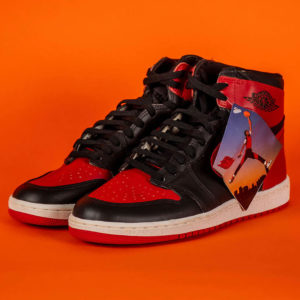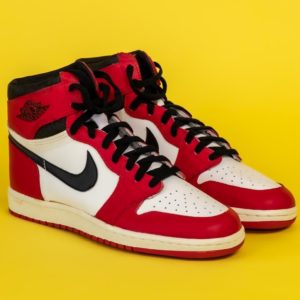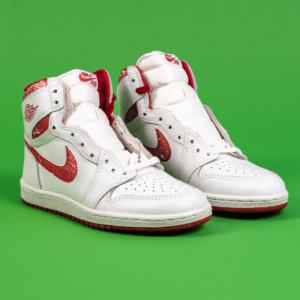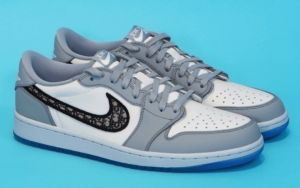Jays, J’s, Jordans, Jumpans, Breds: no matter what you call them, everybody’s talking about Nike’s iconic Air Jordan sneakers. Over the past thirty-odd years since they debuted, these kicks have moved out of the realm of mere footwear and become collectibles and investment pieces with a surrounding sneakerhead culture all their own.
But, there are a lot of moving pieces to understanding and valuing Jays that can be hard for a novice. That’s what we’re here for. Consider this a non-sneakerhead’s guide to Air Jordans. (Pro tip: you can use many of the lessons from this guide when sizing up other sneaker brands as well.) Let’s jump in.
What exactly is the Air Jordan?
Let’s start from the very beginning with the man himself: Michael Jordan. MJ is perhaps the most well known living athlete on the planet. As a basketball player, he shattered records with the NBA and won medals at the Olympics. He also has a uniquely lucrative career off the court as a movie star, NASCAR team co-owner, and of course as the name and face of the most prolific sneaker brand of all time, Nike’s Air Jordan.
In 1984 Nike signed a deal with MJ to create his own brand of sneaker. At the time, Converse was the official show of the NBA, so the shoes stood out on the court. Nike had just invented “air soles,” a new technology for their running shoes, and Jordan was known for his unusual ability to get great height while dunking. Thus the name Air Jordan was born.
While a few other athletes had been the face of a sneaker, Air Jordans were the first to start a cultural frenzy, with loyal fandom that remains unsurpassed. Due to some great marketing ploys, like creating a “banned shoe” ad campaign when the NBA started fining Jordan for the colorful shoes, Nike sold +40x their goal, reaching $126 million in year one. Today’s numbers have skyrocketed: Nike sold $4.6 billion in 2020 alone.
What do the numbers attached to Air Jordans mean?
Most Air Jordans are labelled with its edition number 1-35. There are 35 editions in total, numbered sequentially, with a new one coming out about once a year since the Air Jordan 1 debuted in 1985.
Keep in mind, there are different colorways and collaborations within each edition (we’ll get to those next), so there are significantly more than 35 different types of the sneaker. Each has a different design, both visually and functionally. Cardboard Connection has a great basic visual guide to each edition of Air Jordans that you can use as a quick cheat sheet.
Here’s what you need to know about how the edition of an Air Jordan affects the valuation: First off, each edition is released in a limited capacity. Most importantly, shoes have a utility—they are worn. As time goes on, earlier editions get worn-out, lost or ruined, making earlier, good condition editions more rare and thus more valuable.
That’s speaking very generally, of course. Because differing colorways and collaborators are usually released in more limited quantities, these special factors can trump an edition number when it comes to valuation.
There can also be specific importance to certain editions within the sneakerhead world that go beyond chronology—for instance, the Air Jordan 3 is notable because it was the first-ever mid-cut basketball sneaker and because Nike teamed up with legendary Spike Lee for what would become some of the most influential commercials of all time.
Or, since different editions can have different designers, some shoes are popular because of their designer. Tinker Hatfield, for example, is probably the Jordan brand’s most notable designer.
For a general overview of how the design of each edition differs, check out HNHH’s ranking with pictures of each edition’s silhouette.
New jargon alert: when it comes to discussing design on a pair of J’s, you’ll often hear silhouette referenced. That’s because the view from the side gives you the best view of the shoe’s design details.
There are a handful of Jordan Brand sneakers that don’t have an edition number. These are called Team Jordans, and were made in the 90s when the Jordan Brand first started to take more creative control, spinning off as a brand of their own separate from Nike (though still under the Nike umbrella).
What’s a retro?
Retros are recreations of an earlier model (the original is fittingly called an OG), re-released years later using different shoe-making technology with minor changes in material.
That explains why there are so many Air Jordan 1s from different years, even though the OG was released in 1985. There are retros of most editions, but the Air Jordan 1 by far has the most—there are 99 Jordan 1 retros according to Nike’s blog.
In terms of understanding how the two kinds of shoes are different, this video by the Youtube channel VintageKicksGallery is a good first watch. The host compares an 1985 OG Air Jordan 1 to the 2017 retro, and explains why the OG is worth several thousands of dollars and the retro only a few hundred.
The lessons apply across the board for retros, showing how the newer shoes cut corners to make the sneakers more affordable and wearable. At the end of the day, he suggests thinking about it like you would a vintage car: the newer models are faster and smoother for everyday driving, but the classics are worth more because they’re the originals.
What are colorways and why do they matter?
In a nutshell, a colorway is exactly what it sounds like, the unique color combinations on any given pair of Air Jordans. The overall design for an edition usually stays the same, but the color patterns change, like choosing different crayons but staying within the bold lines of a coloring book.
There are so many different colorways, it’s practically impossible to count. For Air Jordan 1s alone, there are 23 different colorways.
Round table. pic.twitter.com/AFuxJl83st
— John Geiger (@JohnGeiger_) January 21, 2015
So what makes a colorway valuable? One factor is whether there’s a good story behind it. For instance, “Flu Game” is a black-and-red iteration of the Air Jordan 12 that got its name because MJ wore this particular colorway during the famous 1997 game 5 of the NBA Finals where he led the Bulls to victory despite being visibly feverish (later rumored to be food poisoning from pizza).
Even without a salacious story, colorways Jordan wore on the court like Bred (the black/red colorway, which emulated the signature colors of the Chicago Bulls and is the shoe famously tied to the Nike “banned” campaign) or the Chicago (the black/white/red colorway that MJ wore most often during the 1985 season) are popular. The earliest colorways, like Metallics and Royals, are often favored. Check out this and more stories behind fan fave colorways in Highsnobiety’s collection.



And, like anything else, some colorways are popular for purely subjective reasons. At the end of the day a sneaker is like any other piece of clothing, people just like what they like! Here’s sneakerhead Youtuber DNA SHOW’s explanation of his Top 5 Jordan 1 colorways, taking into account internet hype, resale value, and yes, personal taste.
How do collabs work?
If you see a pair of Jordans with someone other than MJ’s name attached to them, you’re probably looking at a collab or player edition. As you may have guessed, collab is short for collaboration, where a celebrity, usually a rapper or fashion designer, will help design they’re own dream pair of sneakers. A player edition is made to honor an athlete.
Collabs are extremely valuable for several reasons. First off, they’re released in a limited edition capacity, usually <50, so they’re rare.
Secondly, the association with a beloved celebrity gives the shoe special meaning to fans, while association with a couture designer like Dior might give the shoe more cachet in fashion circles.

The third reason is a little more subjective—they look cool! Collabs often use radical design elements, like Nikki Minaj’s collab doused in pink glitter, setting the apart from the pack. For more info, check out SoleCollector’s list of every Jordan collab ever.
What is “deadstock condition” and why does it matter?
“Deadstock” is sneakerhead lingo referring to unworn sneakers that still have their original tags. These kicks can be worth a premium. It’s the sneaker equivalent of another word you may have heard before in the world of collectables, “mint condition.”
On other platforms like Ebay, you may see a shoe labelled NDS (near deadstock) or even VVVNDS (very very very near deadstock). These labels may mean they have only been tried on once, which is enough to take them out of the running for deadstock status. Since there aren’t any set and clear guidelines for sneaker condition status, you could be taking a risk with what the seller means by NDS.
Another related phrase you might hear in the shoe world is “on ice.” Similarly, this means that the sneakers are not being worn, and the owner is waiting to sell them later on in pristine condition. But if you’re looking to buy an investment piece, be aware that “on ice” can have different meanings for different folks, so you should put more stock in deadstock. For more slang you should know when getting into sneaks, check out GQ’s sneaker guide for beginners.
NOTE: This is different than the general retail definition of “dead stock” spelled as two words, which refers to merchandise that did not sell well and is thus piling up in a warehouse. This dead stock is sold at a hefty discount, so very different than the meaning in the sneaker world!
How does all this relate to other sneaker brands?
While Air Jordans are in a league of their own, you can use many of the lessons from this guide when sizing up other sneaker brands as well. For instance, a lot of the lingo (colorways, collabs, dead stock, retro, OG, editions, etc.) is going to be the same across different shoes, but especially Nikes. So, if you’re looking at a Nike Air Force or Air Max, you can be confident that naming conventions and numbers mean the same thing as they do for Jordans.

